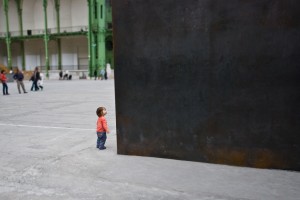
Photo: Guillaume Lemoine.
Last weekend my daughter and I spent the morning at the National Zoo. She turns three later this summer and this was our fifth trip to the zoo since the weather turned nice this spring. Every visit is so different from the last one, even when our path is the same. I never know where she will decide to spend her time. This weekend it was the Amazonian House (a fortuitous side trip that started on the hunt for a potty). Kira was enthralled by the blue frogs, snakes, river fish and stingrays. And I loved discovering how few things she naturally finds yucky (tiger salamanders) and how many yucky things she asks to touch (snakes, frogs and prehistoric looking fish).
On the way home, Kira sound asleep in her car seat, I found myself thinking about the way zoos create, in one installation, experiences that are so deeply engaging for everyone from two year olds to adults. The way that zoos engage families and noise and messiness and crowds, shopping and rides and animals and conservation lessons, and make it all part of a learning experience that people can unpack based on their own growth and interests. And I started thinking about the places Kira and I go regularly – the zoo, the National Air and Space Museum, The Natural History Museum, the American History Museum – and the one museum experience we never seem to make happen: art museums. We draw and paint and look at pictures nearly every day. I love to draw. I love art museums myself. And yet, here we are.
I never thought about it before, but I wish we were creating Children’s Art Museums. Not art museums that children can visit – with ancillary hands-on programs created for them, backpacks they can take with them filled with exercises, and the like – but art museums designed for families and children from two to eighteen years old. Art museums designed around the central mission to build a fascination with visual creativity and visual expression from a young age. Art museums that, like the zoo, would be exciting to my daughter as a two year old and would unfold in additional layers of meaning as she grows.
Imagine what that experience would be like – the collection, the physical spaces, the programs. In my mind the collection would be selected for the importance of the pieces, as in any museum, and also (first, really) for engagement. In much the way top-tier children’s theatres (Childsplay, Oregon Children’s Theatre and others) produce compelling, professional theatre for kids, the Children’s Art Museum would be built around compelling, meaningful art. What could that collection look like? I imagine (using my admittedly idiosyncratic first thoughts, and ignoring all the challenges of creating such a collection) my daughter running around Richard Serra’s sculptures such as “Band” or “Charlie Brown.” Experiencing in those works the way they divide space, their scale, the way sound echoes in their spaces, the views they create, the rough cold feeling of the steel, the disoriented feeling you get when you walk around “Band” and lose your sense of the vertical. I can see kids milling beneath Roxy Paine’s sculpture “Graft” (which they do, in the National Gallery of Art’s Sculpture Garden), looking at the reflections and the light and the shapes and the simple oddity of a stainless steel tree. Andy Goldsworthy’s constructions, Damien Hirst’s butterfly paintings, Wayne Thiebaud’s brightly lit confections, Kosice’s ciudad hidroespacial, David Hockney’s iPad drawings (made on the same device kids love to play with!), Munari’s useless machines, the list goes on (and much further back in time than this). All have enough wonder in them, enough visceral immediate connection to engage young kids. And all have enough creative depth and art-historical meaning to support education about art and visual expression as those kids get older.
What would the experience be like in the galleries of a Children’s Art Museum? Art that can engage kids exists in lots of adult-centered art museums but the space and the experience isn’t designed around kids and families as it is in zoos. I imagine a space that is fun and playful, probably loud and a bit crazy too – not really the place of quiet adult reflection that art museums aim to be today. I imagine a space where “core” and “ancillary” (and revenue generating) activities are integrated together as equal components of the experience as they are when I walk through the zoo, embracing the chaotic energy of kids. Kids and families would flow through exhibits, rides, dining areas, hands-on programming, demonstrations and resting areas as they travel the paths through the museum. I imagine galleries and exhibitions organized by new themes that kids can embrace, such as line or space, color or material, rather than the traditional art-history focus of artist and movement and epoch. Where works need to be protected from small hands, integrated barriers would exist in place of hovering guards and stern warnings. Perhaps a painting would have a railing in front of it with steps and seats for kneeling that make it easy for small kids to get up to see the work, with kid-oriented interpretive information too or a small version of the mounted binoculars that kids love so they can see details of the paint strokes. And maybe we could be practical about where touching is really an issue since touching is a big part of how kids learn. Maybe works like Serra’s, made of weatherproof steel, can handle being handled a bit. And as a parent, I’d love to have an experience that can readily move between outdoors and indoors too for different times of the year and my daughter’s different moods.
A children’s art museum like this would still be valuable and engaging for teens and adults, much as zoos are. Layered programming and information would allow a two year old, an elementary school child, a teenager in high school, and an adult to unpack layers of meaning over time. The museum’s new approach to the experience and organization of art might even encourage adults to think about art in a very different way. Focused on building a love for visual creativity and expression rather than expertise in art history, the museum would likely bring to the forefront different ideas and questions for adults too. I imagine it would be much harder to create quiet, contemplative time with the objects in the Children’s Art Museum but perhaps in return you would better understand them as integrated parts of contemporary life.
Maybe this just sounds like marketing and packaging for art museums, but the visitor experience is a product of the details. If all the details were designed around the mission of “a children’s art museum” to create a love of art and visual creativity from a young age, then the experience (from marketing to every detail on site) would be quite new. Is this just about wonder and amazement – art as amusement park? In some ways, for the youngest, perhaps yes, but then the experience builds on that energy over time, in the same way zoos add ecology and biology and conservation as layers on top of the natural wonder for animals. I often imagine that, back when art museums were first opened to the public, wonder and amazement were a tremendous part of the experience. I think it would be great to have some of that feeling back.
I guess this sort of noodling is what happens when you spend half your time working with some of the top executives in the cultural field asking big questions, and the other half of your time watching a little girl discover the world. I’m pretty lucky on both fronts. So where would you take this (or are you already there)? Anyone want to open the first Children’s Art Museum with me? Or think about the other cultural institutions we have designed for adults and imagine what that experience would look like if it were redesigned for families and children? Would we regain the “lost audience” that disappears for all those years when parents are raising kids and reemerges only after the kids leave for college? Would we have many more kids asking to go to art museums and other cultural institutions the way they ask to go to the zoo today?


